Since 1986, LACMA’s annual Collectors Committee Gala has resulted in numerous important acquisitions for the museum’s encyclopedic collection. The weekend is one of LACMA’s most significant annual fundraising events, and it plays an essential role in acquiring major works of art to expand and strengthen the museum’s collection. During the 29th-annual Collectors Committee Gala, which took place over the weekend, generous Collectors Committee members (87 couples, including 23 new members) pooled funds and voted on which works of art would enter LACMA’s collection.
The Saturday-evening gala opened with exciting news: LACMA CEO and Wallis Annenberg Director Michael Govan announced that Helen Pashgian’s installation, currently on view at LACMA through June 29 in the exhibition Helen Pashgian: Light Invisible, was acquired for the museum through a generous gift from trustee Carole Bayer Sager. The large-scale artwork is made up of twelve two-part columns framed out of molded acrylic; as viewers walk past, between, and around these forms, the sculpture creates an immersive viewing experience that changes based on one’s perspective. Sager, a trustee since 2009, also acquired Barbara Kruger’s Untitled (Shafted), in 2011.
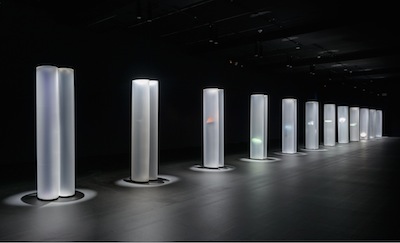 Helen Pashgian, Untitled, 2012–13, gift of Carole Bayer Sager, photo © 2014 Museum Associates/LACMA
Helen Pashgian, Untitled, 2012–13, gift of Carole Bayer Sager, photo © 2014 Museum Associates/LACMA
All told, LACMA raised $4.1 million toward art acquisitions this weekend—a record for the event. Below is the complete list of works proposed by LACMA curators and acquired through the 2014 Collectors Committee. Check back with Unframed throughout the week for a series of short essays on each of these works.
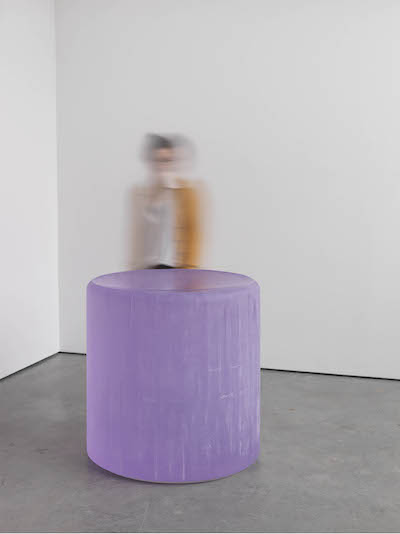 Roni Horn, Untitled ("The sensation of satisfaction at having outstared a baby."), 2013, gift of the 2014 Collectors Committee, with additional funds provided by Steve Tisch, © Roni Horn, photo: Genevieve Hanson
Roni Horn, Untitled ("The sensation of satisfaction at having outstared a baby."), 2013, gift of the 2014 Collectors Committee, with additional funds provided by Steve Tisch, © Roni Horn, photo: Genevieve Hanson
Untitled (“The sensation of satisfaction at having outstared a baby.”) (2013), by Roni Horn, is a form of solid glass. Rendered in vibrant lavender hues, the 3,300-pound sculpture changes according to the conditions and reflections brought on by the presence of natural light. This is the first Roni Horn work to enter LACMA’s collection as well as the first glass piece by Horn to be acquired by a Los Angeles museum.
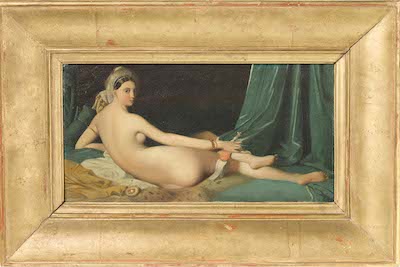 Jean-Auguste-Dominique Ingres, Odalisque, c. 1825–35, gift of the 2014 Collectors Committee, photo © 2014 Museum Associates/LACMA
Jean-Auguste-Dominique Ingres, Odalisque, c. 1825–35, gift of the 2014 Collectors Committee, photo © 2014 Museum Associates/LACMA
Jean-Auguste Dominique Ingres’s small reclining nude is an autograph reduction of the artist's celebrated 1815 Odalisque, a landmark in the painter's oeuvre and a milestone in the representation of the nude in Western painting. Throughout his long career Ingres often repeated his subjects, while altering their image, composition, or style. This recently rediscovered painting is an important contribution to our knowledge of the artist and of his technique: As recently suggested by David Hockney in his discussion of Ingres's drawings, the artist may have used an optical device—such as a "camera lucida"—to reproduce the outline of his original composition. Its details however reveal the artist's hesitations, changes, and additions, which are evidenced in all the versions Ingres painted of the subject.
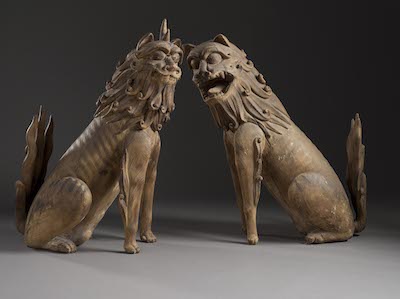 Pair of Guardian Lions, Japan, 9th century, early Heian period (794–1185), promised gift of Lynda and Stewart Resnick through the 2014 Collectors Committee, photo © 2014 Museum Associates/LACMA
Pair of Guardian Lions, Japan, 9th century, early Heian period (794–1185), promised gift of Lynda and Stewart Resnick through the 2014 Collectors Committee, photo © 2014 Museum Associates/LACMA
Dating from the 9th century, the earliest known large-scale wood sculptures of a Pair of Guardian Lions. Each lion was carved from the same source, a sacred tree called shinboku. In Japanese art the nutmeg-yu wood from which they are carved was used for sculpture only between A.D. 750 and 900. These powerful yet playful animals, which seem to speak to each other with their expressive, large heads, would have stood guard at the entrance to a Buddhist temple or Shinto shrine in the early Heian period (794–1185).
 Pablo Picasso, Bull and Picador, 1952, gift of the 2014 Collectors Committee, © 2014 Estate of Pablo Picasso/Artists Rights Society (ARS), New York
Pablo Picasso, Bull and Picador, 1952, gift of the 2014 Collectors Committee, © 2014 Estate of Pablo Picasso/Artists Rights Society (ARS), New York
Bull and Picador (1952), a print by Pablo Picasso that depicts the dramatic moment of a bullfight when the picador stabs the mound of muscle on the bull's neck while, at the same time, the bull gouges the horse's side. The corrida, or bullfight, was a lifelong passion for Picasso and a seemingly ceaseless source of artistic inspiration in all media, but especially in his graphic work. Picasso began working with the master printer Roger Lacouriére in 1934, which marked the beginning of a radically new engagement with intaglio printmaking during which he experimented prodigiously, deploying traditional methods in unorthodox ways to produce many of his most technically complex and accomplished prints. It is a major achievement within Picasso’s graphic oeuvre and a work of utmost rarity.
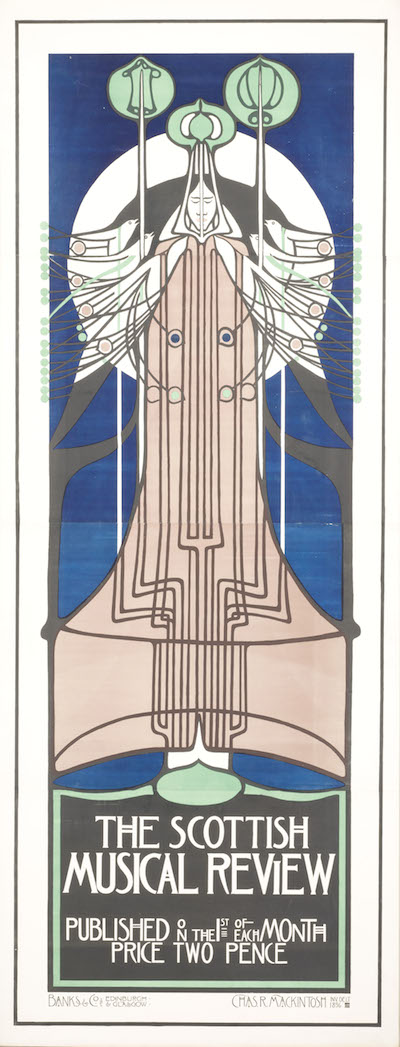 Charles Rennie Mackintosh, Poster for The Scottish Musical Review, 1896, gift of the 2014 Collectors Committee, with additional funds provided by Kitzia and Richard Goodman, J. Ben Bourgeois and Andrew Rhoda, Viveca Paulin-Ferrell and Will Ferrell, Olivier and Zoe de Givenchy, and Laila and Mehran Taslimi, photo © 2014 Museum Associates/LACMA
Charles Rennie Mackintosh, Poster for The Scottish Musical Review, 1896, gift of the 2014 Collectors Committee, with additional funds provided by Kitzia and Richard Goodman, J. Ben Bourgeois and Andrew Rhoda, Viveca Paulin-Ferrell and Will Ferrell, Olivier and Zoe de Givenchy, and Laila and Mehran Taslimi, photo © 2014 Museum Associates/LACMA
This work is Charles Rennie Mackintosh’s extraordinary, nine-foot tall poster for the Scottish Musical Review (1896). Scotland's most renowned designer, Mackintosh has received international acclaim for his architecture and furniture design; his contributions to other media are not as well known. The poster features an elongated, androgynous figure conflated with an abstract, flowering Tree of Life, an image that would be a key component in the design of his most famous building, the Glasgow School of Art, designed at the same time as the poster. Only about 10 examples of this poster are known to have survived.
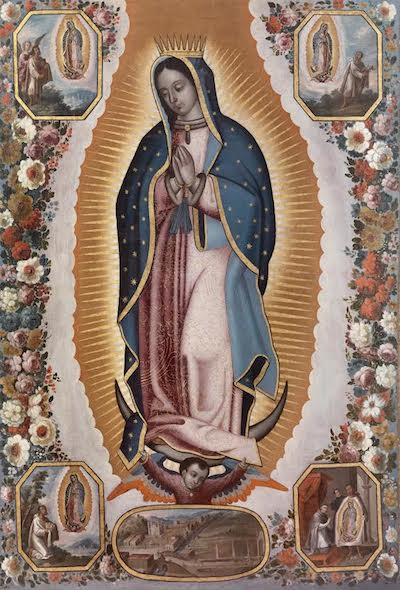 Antonio de Torres, Virgin of Guadalupe (Virgen de Guadalupe), c. 1725, gift of Kelvin Davis through the 2014 Collectors Committee
Antonio de Torres, Virgin of Guadalupe (Virgen de Guadalupe), c. 1725, gift of Kelvin Davis through the 2014 Collectors Committee
A striking painting of the iconic Virgin of Guadalupe by Antonio de Torres, one of the most important painters of the early 18th century in Mexico. This image of the famous wonder-making Virgin shows her surrounded by four roundels detailing her apparitions to the Indian Juan Diego. This emblematic painting of the "Queen of the Americas" bolsters LACMA's collection of Spanish colonial art and its commitment to Latin American art.
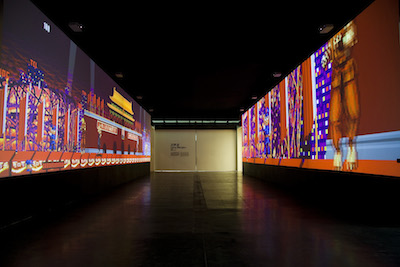 Feng Mengbo, Long March: Restart, 2008, purchased with funds provided by Jane and Marc Nathanson, Ann Colgin and Joe Wender, Mary and David Solomon, Carolyn and John Diemer, and Bryan Lourd through the 2014 Collectors Committee, © image: Feng Mengbo
Feng Mengbo, Long March: Restart, 2008, purchased with funds provided by Jane and Marc Nathanson, Ann Colgin and Joe Wender, Mary and David Solomon, Carolyn and John Diemer, and Bryan Lourd through the 2014 Collectors Committee, © image: Feng Mengbo
Chinese artist Feng Mengbo’s Long March: Restart (2008), a large-scale video installation considered to be one of the most iconic artworks created by a Chinese artist in the past 30 years. The piece combines humor, wit, and cynicism on historical moments in 20th-century China: the Long March, a two-year military retreat in 1933–35 by the Red Army that led to the rise of the Communist Party and the Open Door Policy after the Cultural Revolution as symbolized by the introduction of Coca-Cola in 1979. Long March: Restart is a “side-scroller” video game that is projected onto two facing walls at a life-size scale. The player moves along with the avatar of a digital Red Army soldier tossing cans of Coca-Cola with a soundtrack of revolutionary songs rendered in the style of vintage 8-bit gaming music.
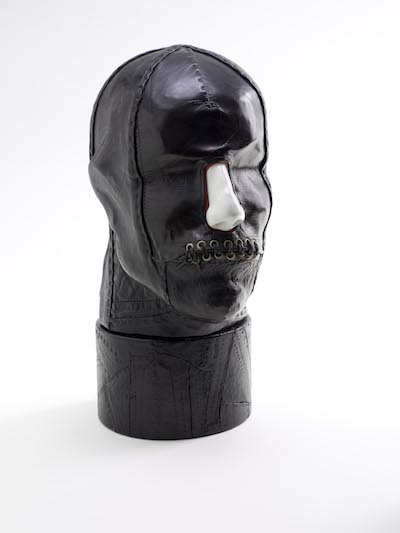 Nancy Grossman, No Name, 1968, gift of Lynda and Stewart Resnick through the 2014 Collectors Committee, © Nancy Grossman, courtesy of Michael Rosenfeld Gallery LLC, New York, NY, photo © 2014 Museum Associates/LACMA
Nancy Grossman, No Name, 1968, gift of Lynda and Stewart Resnick through the 2014 Collectors Committee, © Nancy Grossman, courtesy of Michael Rosenfeld Gallery LLC, New York, NY, photo © 2014 Museum Associates/LACMA
Nancy Grossman’s iconic No Name (1968), a meticulously crafted sculpture carved in found wood and encapsulated by a skin of black leather that was designed, cut, sewn, and tacked together by the artist herself. A cross between sculpture and assemblage, the artist’s leather head suggests strong ties to Surrealism and is part of the feminist movement of the late 1960s and '70s. This is the first Grossman piece to enter LACMA’s collection.
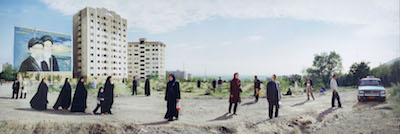 Mitra Tabizian, Tehran 2006, 2006, gift of the Buddy Taub Foundation, Jill and Dennis A. Roach, Directors, through the 2014 Collectors Committee, © Mitra Tabrizian, courtesy Leila Heller Gallery, New York, photo © 2014 Museum Associates, LACMA
Mitra Tabizian, Tehran 2006, 2006, gift of the Buddy Taub Foundation, Jill and Dennis A. Roach, Directors, through the 2014 Collectors Committee, © Mitra Tabrizian, courtesy Leila Heller Gallery, New York, photo © 2014 Museum Associates, LACMA
Iranian artist Mitra Tabrizian’s photograph Tehran 2006 (2006) is a metaphorical study of isolation, displacement, and social upheaval. Tabrizian’s fascination with contemporary Iranian cinema informs her photographic work, including this piece, which is photographed like a wide-angle shot in a film. Staged in a then-recently developed residential section in the northwestern area of Tehran, the setting evokes a society without a functioning infrastructure, where the directionless inhabitants are ironically juxtaposed with a billboard that reads: "We will continue [on] the path of the imam and martyrs of the Revolution."
Linda Theung



